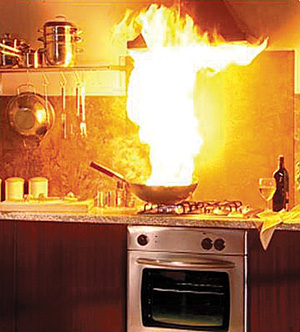Fire Prevention Week 2013
Each year, across the country, the fire service celebrates Fire Prevention Week. Fire Prevention week is celebrated around the anniversary of the Great Chicago Fire that occurred on October 9 1871. It is a time to focus on fire safety and educate the public in the hopes that a tragedy such as this will not happen again.
This year, Fire Prevention Week takes place on October 6 – 12. A different theme is chosen for Fire prevention week each year. This year the theme is “Prevent Kitchen Fires.” Cooking has been identified as the major cause of fires in the home and a significant cause of fire related injuries and deaths.
How can fires be prevented in the kitchen? Cooking is an activity that should be monitored at all times and here are some safe practices that can reduce the chances of having a fire in your kitchen.

Keep all cooking surfaces clean. Excessive grease and food residue should be cleaned from the stove and oven between uses.
Do not wear loose clothing when cooking. Loose clothing can easily come in contact with heating elements and open flame. If your clothing catches fire, remember to stop, drop and roll until the flames are extinguished.
If you experience a fire in the kitchen, try not to panic.
The first step in any stovetop or oven fire is to turn off the burner or oven.
Even if you extinguish the fire yourself, call the fire department to ensure that the fire is completely extinguished.
Do not fight cooking fires with water. Water can spread a kitchen fire if flammable liquids such as grease or cooking oils are involved that are lighter than water and will float on top. The burning liquid will continue to burn and spread the fire over a larger area. Water, if applied forcefully to a burning liquid, can splash the flaming liquid causing it to spread to other areas of the kitchen or splash back on you causing burns or igniting your clothes.
Extinguish a grease or oil fire in the kitchen by using a lid. When cooking, always place the lid that fits the pot or pan being used on the counter top next to the stove with an oven mitt. If the food catches fire, turn off the heat, put on the mitt and place the lid over the pot or pan. The fire should extinguish itself.
Don’t try to move a burning pot or pan from the stove. By moving a pot or pan that is burning you may spread the fire to other parts of the home or spill burning food on yourself causing a serious burn.
Do not use materials such as baking soda or cornstarch to extinguish a cooking fire. They may work initially, but organic substances such as these can overheat and start to burn. They provide no cooling effect on the fire and may not smother it as effectively as a lid.
If there is a fire in the oven, never open the oven door. You could expose yourself to smoke, flame and superheated air. The first step, as with stovetop fires, is to turn off the heat. Keep the oven door closed to limit the oxygen supply to the fire. Call the fire department even if you manage to extinguish the fire yourself. Firefighters will make sure that the fire is completely extinguished and remove the burned items from your home safely.
Other safe practices for the kitchen:
Maintain a three-foot safety area around all kitchen appliances. Children and pets should be kept clear of this area when food is being cooked.
Handles on pots and pans should always be turned in, away from the front edge of the stove to prevent accidental spills of hot food or liquid or to keep a child from grabbing the handle
In addition to safe cooking practices, make sure that the rest of your home is fire safe. Test your smoke and carbon monoxide alarms monthly. Make sure that you change the batteries in both types of alarms at last once a year. A fire extinguisher is also good item to have on hand in the event of a small fire in your home. Make, and practice, a fire safety plan with your family before an emergency happens.
•••
For additional fire safety information, contact your local fire department. For the Aptos/La Selva Fire Protection District, call 685-6690. For the Central Fire Protection District, call 479-6842